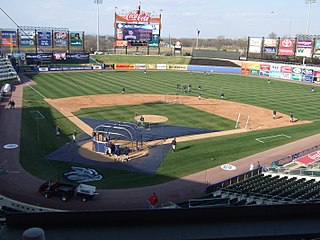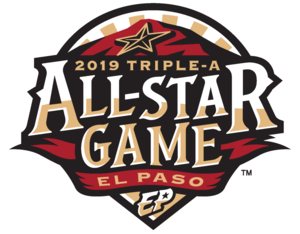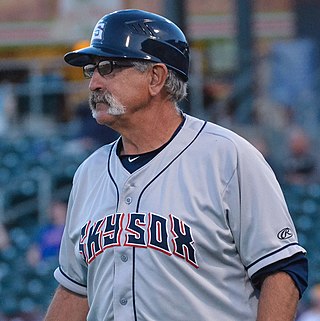The Pacific Coast League (PCL) is a Minor League Baseball league that operates in the Western United States. Along with the International League, it is one of two leagues playing at the Triple-A level, which is one grade below Major League Baseball (MLB).

The Norfolk Tides are a Minor League Baseball team of the International League and the Triple-A affiliate of the Baltimore Orioles. They are located in Norfolk, Virginia, and are named in nautical reference to the city's location on the Chesapeake Bay. The team plays their home games at Harbor Park, which opened in 1993. The Tides previously played at High Rock Park in 1961 and 1962, Frank D. Lawrence Stadium from 1961 to 1969, and at Met Park from its opening in 1970 until the end of the 1992 season.

The Columbus Clippers are a Minor League Baseball team of the International League (IL) and the Triple-A affiliate of the Cleveland Guardians. They are located in Columbus, Ohio, and are named for speedy merchant sailing vessels known as clippers. The team has played their home games at Huntington Park since 2009. They previously played at Cooper Stadium from 1977 to 2008.

The Louisville Bats are a Minor League Baseball team of the International League (IL) and the Triple-A affiliate of the Cincinnati Reds. They are located in Louisville, Kentucky, and are named in dual reference to the winged mammal and baseball bats, such as those manufactured locally under the Louisville Slugger brand. The team plays their home games at Louisville Slugger Field, which opened in 2000. The Bats previously played at Cardinal Stadium from 1982 to 1999.

The American Association (AA) was a Minor League Baseball league that operated primarily in the Midwestern and South Central United States from 1902 to 1962 and 1969 to 1997. It was classified as a Triple-A league, which is one grade below Major League Baseball, for most of its existence.

The Indianapolis Indians are a Minor League Baseball team of the International League (IL) and the Triple-A affiliate of the Pittsburgh Pirates. They are located in Indianapolis, Indiana, and play their home games at Victory Field, which opened in 1996. The Indians previously played at Owen J. Bush Stadium from 1931 to 1996 and at two versions of Washington Park from 1902 to 1931.

The Omaha Storm Chasers are a Minor League Baseball team of the International League and the Triple-A affiliate of the Kansas City Royals. They are located in Papillion, Nebraska, a suburb southwest of Omaha, and play their home games at Werner Park, which opened in 2011. The team previously played at Johnny Rosenblatt Stadium from 1969 to 2010.

The International League (IL) is a Minor League Baseball league that operates in the United States. Along with the Pacific Coast League, it is one of two leagues playing at the Triple-A level, which is one grade below Major League Baseball (MLB).

Elmer John Smith was an American professional baseball outfielder who played in Major League Baseball for the Cleveland Indians, Washington Senators (1916–17), Boston Red Sox (1922), New York Yankees (1922–23), and Cincinnati Reds (1925).

Robert Joseph Hoover was a professional baseball player from 1937 to 1946. He played three years in Major League Baseball as a shortstop for the Detroit Tigers from 1943 to 1945. He also played six years in the Pacific Coast League (PCL) for the Hollywood Stars from 1938 to 1942 and the San Francisco Seals in 1946. He won a World Series championship with the Tigers in 1945 and a PCL pennant with the Seals in 1946. He was also selected as a PCL all-star and the Hollywood Stars' most valuable player in 1942 when he hit for a .327 batting average.

Triple-A has been the highest level of play in Minor League Baseball in the United States since 1946. Currently, two leagues operate at the Triple-A level, the International League (IL) and the Pacific Coast League (PCL). There are 30 teams, one per each Major League Baseball (MLB) franchise, with 20 in the IL and 10 in the PCL. Triple-A teams are generally located in smaller cities as well as larger metropolitan areas without MLB teams, such as Austin, Jacksonville, Columbus, and Indianapolis. Four Triple-A teams play in the same metro areas as their parent clubs, those being the Gwinnett Stripers, St. Paul Saints, Sugar Land Space Cowboys and Tacoma Rainiers.

The Triple-A National Championship Game is a single interleague postseason baseball game between the league champions of the two affiliated Triple-A leagues of Minor League Baseball (MiLB)—the International League (IL) and Pacific Coast League (PCL)—to determine an overall champion of the classification. With the exceptions of 2020 and 2021, the game has been held at the end of each season since 2006.

The Triple-A All-Star Game was an annual baseball game held from 1988 to 2019 between professional players from the affiliated Triple-A leagues of Minor League Baseball. These leagues were the International League (IL) and Pacific Coast League (PCL) from 1998 to 2019. Previously, the American Association competed along with the IL and PCL before it disbanded following the 1997 season. The 2020 game was cancelled along with the entire minor league season due to the COVID-19 pandemic. The 2021 game was postponed and not rescheduled after a delayed start to the season. There has been no announcement about its resumption in the future.

Ricky Joe Sweet is an American former professional baseball catcher and current manager of the Milwaukee Brewers' Triple-A affiliate, the Nashville Sounds. He played three seasons in Major League Baseball (MLB) between 1978 and 1983 for the San Diego Padres, New York Mets, and Seattle Mariners. Sweet became a major league coach in 1984 and spent two years as a scout before beginning his minor league managerial career in 1987.

The Portland Beavers was the name of separate minor league baseball teams, which represented Portland, Oregon, in the Pacific Coast League (PCL). The team was established in 1903, the first year of the PCL.
The Triple-A Classic was an interleague postseason championship series held annually between the league champions of the American Association (AA) and International League (IL) Triple-A leagues of Minor League Baseball from 1988 to 1991.
The Triple-A Alliance was an interleague partnership between the American Association (AA) and International League (IL) Triple-A leagues of Minor League Baseball from 1988 to 1991. The two leagues played an interlocking schedule consisting of 40 to 44 interleague games per team. At the end of each season, an Alliance champion was determined in the Triple-A Classic, a best-of-seven postseason series.

The Nashville Sounds Minor League Baseball team was established in Nashville, Tennessee, in 1978, after Larry Schmittou and a group of investors purchased the rights to operate an expansion franchise of the Double-A Southern League. The Sounds played their home games at Herschel Greer Stadium from its opening in 1978 until the end of the 2014 season. In 2015, the Sounds left Greer for First Tennessee Park, now known as First Horizon Park, a new facility located on the site of the historic Sulphur Dell ballpark, home to Nashville's minor league teams from 1885 to 1963.



















